Table of contents
Executive summary
What are the top expectations, concerns and priorities for the leaders of small to midsize businesses in 2024? Insperity regularly surveys hundreds of HR and business leaders from across its client roster of small and midsize businesses to understand their performance expectations, business concerns and HR priorities. Key findings from the surveys in Q4 2023 and Q1 2024 include:
- Clients had a positive outlook for their organizations entering this year. Most survey respondents expected to end 2023 about the same or better than they anticipated at the start of the year, and most were optimistic about their organization’s performance for 2024.
- Talent is top of mind in many organizations. Business and HR leaders are focused on trying to keep employees and forging stronger connections with them. Talent retention was the HR concern most cited by respondents, followed by employee engagement and culture.
- More work needs to be done to upskill employees. Less than 3 in 10 business and HR leaders surveyed are very confident their employees have the skills needed to drive organizational success. Fortunately, a majority of leaders said their organization either has a strategy in place or anticipates putting one in place to upskill and train workers to build their capabilities.
- Clients are trying to keep pace with the changing nature of work. Remote and hybrid work schedules continue to evolve, but they’re here to stay. A majority of respondents are using remote and/or hybrid work as part of their talent strategy. Respondents are also increasingly thinking about the role of AI in their business. Most, however, don’t yet have a policy in place for the use of generative AI in their business.
The state of small and
midsize businesses
Business and HR leaders are optimistic
Small and midsize businesses were resilient in 2023. Despite a challenging business environment, most business and HR leaders surveyed in Q4 2023 expected their organization’s performance at the end of 2023 to be about the same (41%) or better (42%) than they anticipated at the beginning of the year. Looking ahead to 2024, respondents were most optimistic about what they could control. For instance, 6 in 10 expressed an optimistic outlook about their company’s performance for 2024, while only 1 in 10 expressed a concerned outlook.
CURRENT OPTIMISM
Q1 2024 Outlook
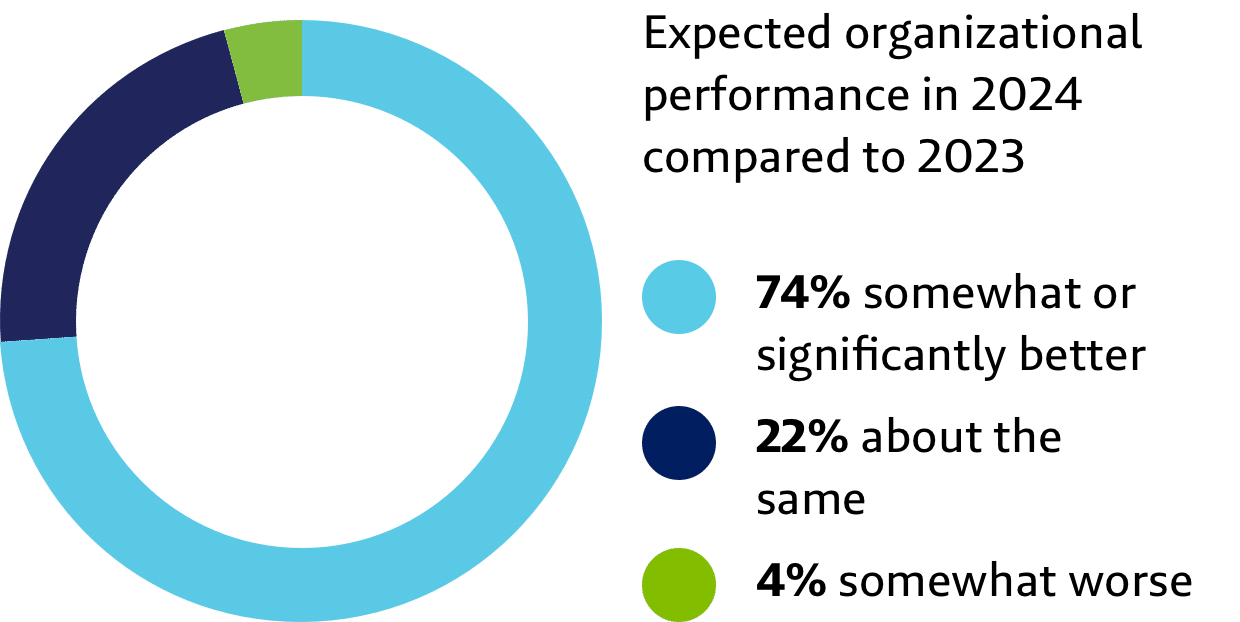
People are a priority
A clear finding from the surveys is that keeping talent is a priority for organizations today. When respondents were asked about their top HR concerns in Q1 2024, the most cited were talent retention (56%), culture (55%) and employee engagement (51%). No other concerns were cited by more than half of respondents.
Top HR concerns
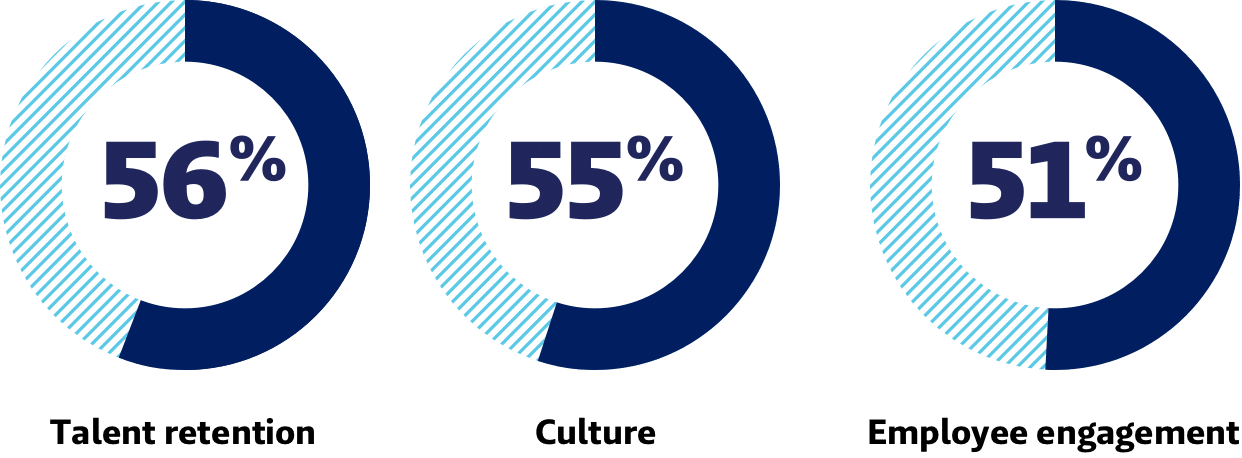
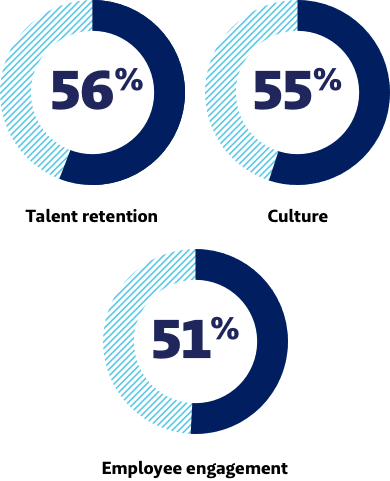
Additionally, when asked about their concerns with respect to workplace-related changes that could happen in the future, 3 in 4 respondents said they were very or somewhat concerned about employees feeling less connected to their team or organization. A similar number of respondents said they were somewhat or very concerned about reduced employee loyalty.
Companies can better understand how to retain employees by learning why they quit. Pew Research Center found, for example, workers who quit their jobs in 2021 – in a period now known as the Great Resignation – did so for financial, personal and professional reasons.
A recent survey found the top five reasons why working professionals wanted to quit were:
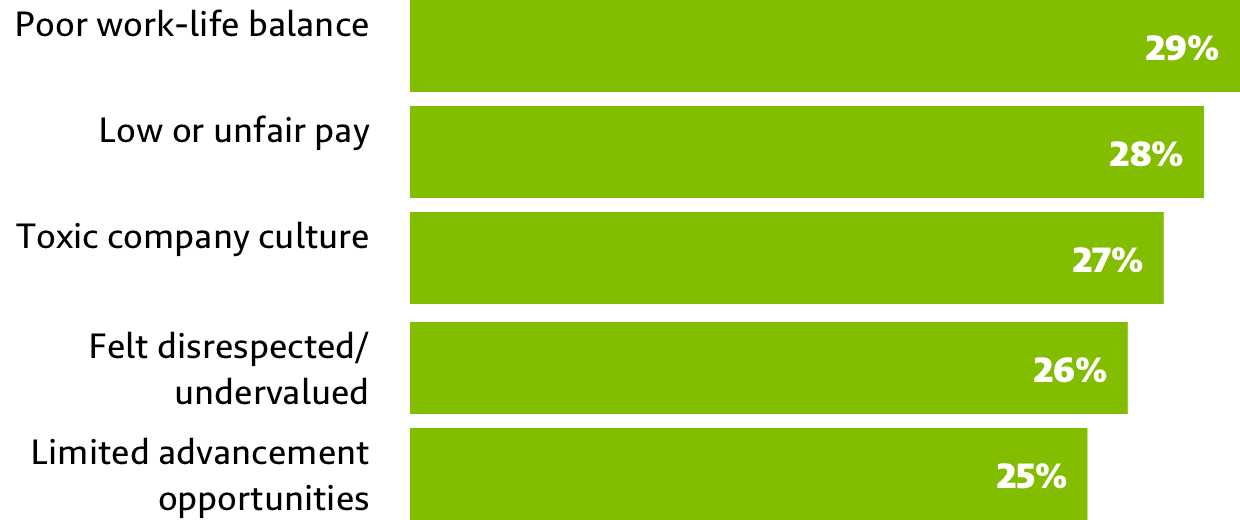
If this diverse list tells companies anything, it’s that they need a multi-faceted retention strategy that addresses employees’ financial, personal and professional wants and needs.
A good place to start is with that critical but intangible thing that’s intertwined with every aspect of an employee’s job – culture.
Creating an employee-
centered culture
Insperity clients are working to improve employee engagement and culture, and survey respondents specifically stated that they approach this through the use of onboarding processes (41%) and employee surveys (30%), as well as team-building initiatives (47%) and employee events outside work hours (40%).
Approaches to improve employee engagement and culture
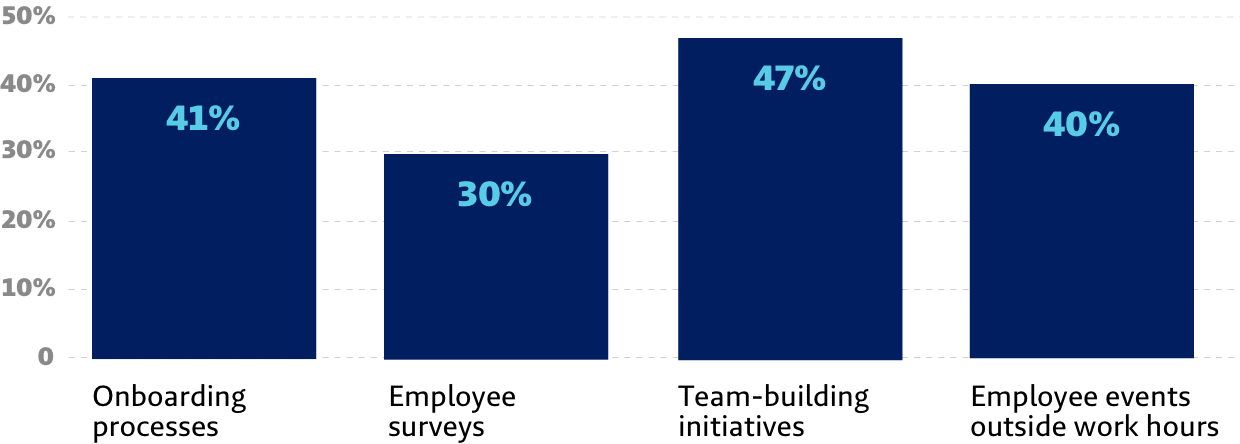
However, what works for one company may not work for another. All efforts to build and improve a company’s culture should be tightly aligned with the needs, desires and values of that company’s employees. That can only happen if companies work to understand their employees.
Employee surveys and one-on-one meetings with leaders can provide insights into what employees want or need in their work and in their employer. Do they want greater flexibility in where they work? Higher pay? More time off?
Building a strong culture in a company also requires building trust within the company. That trust can be established in various ways, including creating stronger relationships between employees and company leaders. Nearly 6 in 10 business and HR leaders surveyed by Insperity, for example, said their organizations have considered or implemented leadership open-door policies to improve employee engagement and culture.
Another key contributor to a company’s culture is leadership style, especially for the front-line leaders who interact with employees the most.
Putting an emphasis on creating close relationships, where leaders show they understand, care about and believe in employees as people – while still being able to set expectations for them – can create stronger, more genuine interpersonal connections in organizations. This can give employees a greater sense of belonging and help front-line leaders better understand employees.
Consideration or implementation to open-door policies

Considered an open-door policy
Leaders should also be willing to be vulnerable with employees to help build trust and strengthen relationships. And they should establish psychological safety with their teams, meaning that all team members can feel comfortable expressing themselves, which can lead to increased employee engagement, morale, commitment and productivity.
To foster these stronger relationships, front-line leaders may need to develop their skills in areas such as active listening. A variety of in-person and virtual classroom training services are available to help them do this. Companies should also have a written employee value proposition, so employees know what to expect when working for them. And they should consider holding a mission, vision and values workshop to understand how they can create a more employee-centered culture in which leaders model and encourage their company’s values to be lived out through every interaction.
Staying competitive with
the right skills
Equipping employees with the skills they need today and into the future remains a constant challenge as technology continues to reshape business and work. In Insperity’s survey, most respondents were confident their workers have the skills necessary to drive organizational success, but only about 3 in 10 were “very confident.” Additionally, 1 in 4 respondents said upskilling and/or workforce training is a top HR concern.
Confidence in employee skills and upskilling concerns

Respondents were very confident in employee skills

Respondents said upskilling and/or workforce training is a top HR concern
Certainly, organizations have an opportunity to take steps to make sure employees have the skills they need. For example, under half of respondents said they have a strategy in place to build the capabilities of current workers with upskilling and training. However, 34% said they anticipate putting such a strategy in place but haven’t done so yet, while 15% said they haven’t considered it but should.
One barrier to upskilling can be employees believing they don’t have time for it. Indeed, in a DeVry University survey, 4 in 10 workers said there isn’t enough time in the day for upskilling. This is where front-line managers can play a critical role. They can carve out time for employees to focus on upskilling efforts and make sure employees are supported in those efforts as needed.
A blended learning approach can also help. Rather than requiring employees to be away from their jobs for long stretches, these approaches allow employees to develop new skills at a pace that works best for them.
At the same time, while learning or training initiatives play an important role in upskilling, they’re also not enough. They provide the transfer of knowledge to an employee. But the transfer of skills doesn’t happen until an employee uses what they’ve learned in an application.
Strategies for building employee skills
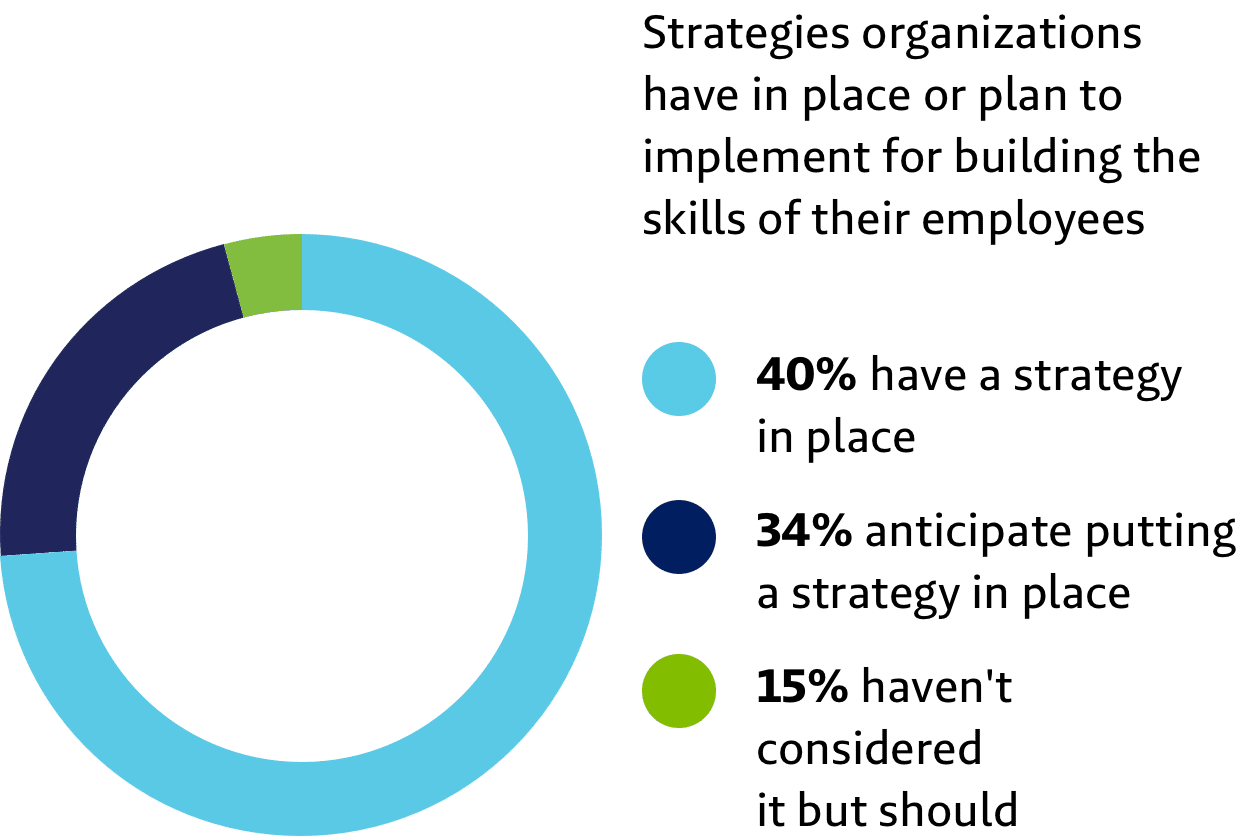
Stretch assignments can provide a good opportunity for employees to apply their newfound knowledge and get experience in new roles. Mentors can also help ease an employee’s transition into a new or expanded role. Additionally, an accountability partner can help keep learning alive and reinforce it.
Alongside upskilling current employees, companies should be thinking about how they can prepare prospective employees for future changes, such as by pre-skilling. This involves looking ahead to understand what skills will be needed in the future and hiring to those skillsets today. Some companies are also putting a greater focus on employee potential by looking for job candidates who have transferable skills that could help them take on new roles or responsibilities in the future with minimal training. And some companies are using contingent workers to help fill skills gaps.
Finally, it’s worth remembering upskilling benefits the employee just as much as it benefits the employer.
Many employees are eager to build their skillsets and advance their career. By supporting employee upskilling – in the ways discussed, as well as with incentives such as reimbursements for training, education and certifications – companies can develop the skills they need to stay competitive and strengthen employee engagement and retention in the process.
The compensation equation
Four out of 10 respondents in the Insperity survey said compensation is a top HR concern. More than half (59%) said that remote and/or hybrid work, along with compensation reviews and more competitive wages (48%) are the top-used practices in their talent strategy. The burning question for companies is, how can they offer competitive compensation without breaking the bank?
A good place to start is knowing what other employers are paying. Reviewing salary survey data can help companies understand market-rate pay and inform their own compensation approach. Services are available to provide this data from reputable vendors and customize it to a company’s size, location and industry.
Companies also need to consider compensation within their larger total rewards approach. While employees value pay, they also care about other things employers provide, including work flexibility, time off and other benefits. By understanding what employees want, companies can put together a total rewards package that offsets compensation with desirable work options and benefits.
Of course, it’s easier to make intentional and consistent compensation decisions with some key foundational elements in place.
- First, a compensation philosophy provides guiding principles and an explanation for an organization’s approach to compensation. It can give company leadership guidance and a reference point when making compensation decisions. As companies make pay information more available in compliance with pay transparency laws, a philosophy can improve how a company communicates pay information and help employees understand why their employer pays what it does.
- Companies should also consider establishing a formalized compensation program that includes salary ranges and pay policies. Such a program can give HR professionals and managers a defined framework to stay within when they post jobs, make and negotiate offers with candidates and promote employees. Qualified compensation support professionals can help create these programs.
Navigating the ongoing
evolution of work
Work was forever changed during the pandemic, and it will only continue to evolve in the coming months and years. Some key factors driving this change include:
Remote and hybrid work
News headlines may be putting an emphasis on return-to-work policies, but remote and hybrid work schedules are here to stay in some capacity. The Insperity survey found 6 in 10 business and HR leaders said their organization was using remote and/or hybrid work as part of their talent strategy.
Adoption of remote and hybrid work strategies

Use remote and/or hybrid work as part of their talent strategy
However, companies still have work to do to determine what their work model will look like and how to keep employees engaged and a part of the company culture even when they’re not in the office.
Every company’s remote or hybrid work strategy will be shaped by factors such as what the work and the teams require of the employees. However, companies should keep in mind today’s younger workers prefer hybrid work. Drawing hard lines requiring that workers be in the office will need to be backed up by hard data and solid reasoning.
When it comes to engaging remote and hybrid employees, the sooner the better. Companies that make a strong first impression on these employees can help them feel connected to their colleagues, the company and its mission soon after they start their jobs.
Disruptive technology
Generative artificial intelligence (AI) applications such as ChatGPT have sparked widespread interest in how AI can save companies time and money by automating tasks and making them more efficient. In Insperity’s July 2023 survey, 56% of client respondents said they were thinking about AI relative to their business. That was a 25-point increase from those who said they were doing the same just three months prior.
However, for all the potential AI holds, it also presents many risks and challenges companies will need to address before they embrace it. The Equal Employment Opportunity Commission, for example, has raised concerns about how using AI for employment decisions could violate civil rights laws.
Surge in interest in AI applications
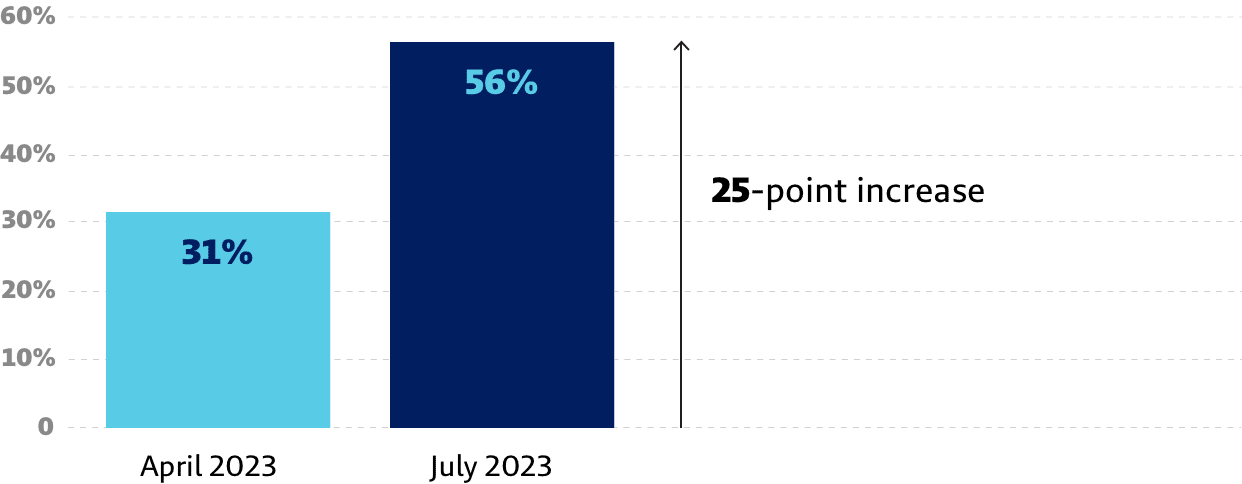
To help address these concerns, companies should put a policy in place for the use of generative AI at work. In Insperity’s Q4 2023 customer survey, only 1 in 10 respondents said their organization had such a policy in place.
Having a policy can give employees processes and guidance for how they should – or shouldn’t – use AI in their jobs. It can even enable greater use of AI by establishing a formal process for employees to vet their ideas for using AI to help potentially bring those ideas to life.
Adoption of policies for generative AI

Had a policy in place
Contingent workers
The independent workforce has grown in recent years, climbing from 27% of the U.S. workforce in 2016 to 36% in 2022. Making sure workers feel like a part of the team will be key for companies in the coming years as this workforce continues to grow. Case in point: A recent survey found about two-thirds of global executives said they plan to increase their use of contingent workers in the next two years – but 70% said they are challenged when integrating such workers into their workforce.
Company leaders may view contingent workers as temporary and not part of their permanent workforce. However, companies should still consider that the more engaged contingent workers are and the more they feel like they’re a part of something larger than their day-to-day job, the more productive they’ll likely be.
Creating a healthy, happy
workforce
Rising health care costs made big headlines late last year. And not surprisingly, 43% of Insperity clients surveyed said managing such costs is a top HR concern.
Managing employee benefit costs is a key reason companies work with a professional employer organization (PEO). But there are also steps companies can take on their own to help contain these costs. One of them is incentivizing preventive-care services, such as:
- Providing 100% coverage of preventive services, which can remove financial barriers to care for employees and their families.
- Using rewards programs to encourage employees to receive preventive care by earning points they can spend on items ranging from gift cards to fitness-tracking devices.
- Providing paid “care time” for employees to go to their annual checkup while staying on the clock at work.
However, while these steps can help rein in costs, they’re only part of the solution. Companies that want to reduce their health care costs while promoting a healthy, happy workforce should consider taking a whole-person approach to wellness.
This approach recognizes that each employee has unique physical, mental, social, financial and professional health needs. By giving employees tools and resources to help manage each of these aspects of their health, companies can make a real impact in employees’ lives while helping them be more engaged and productive at work.
A key goal for this approach, or any wellness approach, should be flexibility. For instance, not everyone seeking mental health care wants to go sit on a provider’s couch. Making other services such as virtual and text-based counseling available can give these employees options they’re more comfortable with and more likely to use.
Nearly all wellness programs will have some common elements, but there’s no one-size-fits-all formula that works for every company. Each program should be unique based on the make-up of the employee base and the nature of work done by those employees.
A good place to start is to simply ask employees what they want in a wellness program. An annual survey can help companies more clearly understand what employees like and what they feel is missing in their wellness programs.
In some cases, an employee survey can help spark new ideas. A good example of this happened with an Insperity client that is a Fortune 1000 company. An employee responding to a survey suggested that the client provide more awareness about its vacation resources. This led to the client posting an article on their wellbeing intranet site about what Insperity offers for vacation planning, and it became the top-performing article ever posted on the site.
Surveys can also reveal education gaps about wellness programs. Employees could be asking for wellness tools and services their company already offers, but they just don’t know about them. Alternatively, employees could have misconceptions about existing services.
Finally, companies should keep in mind that making strides in other areas of their talent strategy can also impact employee wellness. If employees are not being recognized for their work or given opportunities to grow, for example, they may not be happy. Feeling like they’re underpaid or being forced to come into the office more than necessary can also create dissatisfied workers.
Conclusion
What’s next?
Companies face many of the same challenges when it comes to building and maintaining the workforce they’ll need to compete in the future. However, every company’s journey for solving these challenges will be different. Small and midsize companies also may feel limited in their ability to confront workforce challenges because they have smaller HR departments that are already at capacity with their day-to-day responsibilities, or they may have no HR department at all.
By partnering with Insperity, companies can bring focus to their workforce strategy and identify where their biggest opportunities exist. They can also augment their in-house teams with HR professionals who have experience in areas such as culture and talent strategies, compensation and learning and development.
About the survey
Insperity conducted its most recent business outlook surveys in October 2023 with 578 respondents and January 2024 with 498 respondents. Insperity sent the online survey to HR and business leaders across its client base of small and midsize businesses based in the U.S. The data in this survey may not be representative of the entire U.S. market. Both surveys have a statistical confidence level of 95% and a margin of error of 4%.
About Insperity
Since 1986, Insperity’s mission has been to help businesses succeed so communities prosper. Offering the most comprehensive suite of scalable HR solutions available in the marketplace, Insperity is defined by an unrivaled breadth and depth of services and level of care. Through an optimal blend of premium HR service and technology, Insperity delivers the administrative relief, reduced liabilities and better benefit solutions that businesses need for sustained growth. With 2023 revenues of $6.5 billion and more than 90 offices throughout the U.S., Insperity is currently making a difference in thousands of businesses and communities nationwide. For more information, visit insperity.com.

